December 29, 2017

After six years of careful development, Julie Auch harvested her first commercial crop of aronia berries this year. The 7-acre orchard near Menno, S.D., produced 17,000 pounds of berries from 3,000 bushes. Auch expects to receive a gross payment of about $1.60 per pound.
“In terms of maturity, my berries are young,” she says. “Once they reach maturity, each bush can potentially produce 20 pounds of berries.” That would be 60,000 pounds of berries from a 7-acre orchard.
Superfruit
Aronia are a genus of deciduous shrubs, the chokeberries. Aronia berries contain more antioxidants than almost any other food in the world. Native Americans used them to treat bacterial and fungal infections as well as the common cold. Recent research indicates that aronia berries can have a significant impact on eye, brain, circulatory, joint, digestive, blood and heart health.
Auch’s interest in aronia berries grew out of the need to find nutrition-dense foods for a family member battling cancer.
“When I learned that aronia berries are the most nutritious fruit in the world and were native to our Northern Plains, I knew I wanted to grow them,” she says.
Three years to fruit
“It takes at least three years for aronia bushes to produce enough berries for a significant harvest,” Auch says. “Weed control, especially for organic production, can be a real challenge.”
Some growers use landscape fabric, but Auch primarily relied on cultivation, mowing and mulch. Her nutrient inputs have been low, averaging some $100 per acre.
If it hadn’t been for a late spring killing frost that took out 75% of her aronia berry blossoms, Auch would have harvested her first commercial crop in 2015. While she had a significant amount of berries to harvest in 2016, there was no market for the fruit.
This year, Auch is selling her berries through National Aronia Growers, a group formed in 2015 to aggregate berries from growers and sell them to large food companies. It currently has more than 200 members and they produced more than 1 million pounds of berries.
Auch hopes growing the berries will be profitable.
They have the potential to show a much better return per acre than traditional field crops. “And the product is something we can be proud to provide to consumers,” she says.
Northwest Iowa company processes aronia berries
Aronia berry growers Tony and Jennifer Heisterkamp and Mary and John Lucken, of Akron, Iowa, are partners in an aronia berry processing and marketing company: Akron Apple & Aronia Inc. Their products include 100% aronia berry juice, aronia berry honey and creamed honey, frozen aronia berries and aronia berry powder.
Initially, they sold their Akronia Valley-branded products to independent health food and grocery stores, with sales of one or two cases of product at a time. As more consumers learned about aronia’s health benefits, demand grew quickly in the area, Tony says. Currently, Maynard’s Food Center sells aronia products in all 16 of its stores across South Dakota, Minnesota and Iowa, and Hy-Vee recently began stocking products in its distribution warehouse. A number of local wineries are also purchasing aronia berries to produce a variety of wines.
The Heisterkamps started an online aronia store, Lifebrook. They offer juice supplements, aronia concentrated power, aronia vitamin supplements and other products.
For information about producing or selling aronia berries, contact Heisterkamp at 712-540-0127 or [email protected]. To learn more about aronia food products, visit akroniavalley.com and lifebrook.com.
Sorensen writes from Yankton, S.D.
About the Author(s)
You May Also Like




